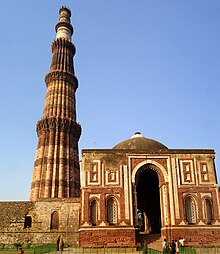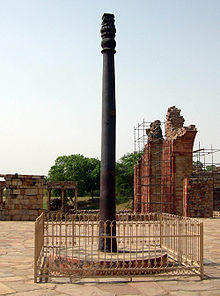Qutb Minar complex
| UNESCO World Heritage Site | |
|---|---|
 Qutub Minar | |
| Location | Mehrauli, India |
| Criteria | Cultural: iv |
| Reference | 233 |
| Inscription | 1993 (17th Session) |
| Coordinates | 28°31′28″N 77°11′08″E / 28.524382°N 77.185430°E |
The Qutb Minar complex are monuments and buildings from the
Many subsequent rulers, including the
Today, the adjoining area spread over with a host of old monuments, including
Alai Darwaza

The Alai Darwaza is a main gateway from southern side of the qutub.
The
Qutb Minar

The
Built as a Victory Tower, to celebrate the victory of
The
Inscriptions also indicate further repairs by Sultan
After an accident involving school children, entry to the Qutub Minar is closed to public since 1981, while Qutub archaeological area remains open for public.[24] In 2004, Seismic monitors were installed on the minar, which revealed in 2005 Delhi earthquake, no damage or substantial record of shakes. The reason for this has been cited as the use of lime mortar and rubble masonry which absorbs the tremors; it is also built on rocky soil, which further protects it during earthquakes.[22]
Quwwat-ul-Islam Mosque

The Quwwat-ul-Islam (
'The conqueror entered the city and its vicinity was freed from idols and idol-worship; and in the sanctuaries of the images of the gods, mosques were raised by the worshippers of the one God.'
— Quṭb al-Dīn Aibak's chronicler, Hasan Nizami, Taj-ul-Maasir[27]
It was the first mosque built in Delhi after the Islamic conquest of India and the oldest surviving example of

Of the site selected by Aibak for the construction of a mosque,
The mosque is one of the earliest extant mosques in India. The original dimensions of the mosque had a courtyard measuring 43 m (141 ft) by 33 m (108 ft). The prayer hall, located on the west measures 45 m (148 ft) by 12 m (39 ft). The mosque has grey colonnades made of greystone with three bays in east and two bays deep on the north and the south. Extensions were made to the mosque during 1296 when its dimensions in north and south were extended by 35 m (115 ft). The famous iron pillar is located on the stone pavement in front of it, while
The mosque is built on a raised and paved courtyard, measuring 141 ft (43 m) × 105 ft (32 m), surrounded by pillared
The mosque is in ruins today but indigenous
Iron pillar

The iron pillar is one of the world's foremost metallurgical curiosities. The pillar, 7.21-metre high and weighing more than six tonnes, was originally erected by
The estimated weight of the decorative bell of the pillar is 646 kg while the main body weighs 5,865 kg, thus making the entire pillar weigh 6,511 kg.[37] The pillar bears an inscription in Sanskrit in Brahmi script dating 4th century AD, which indicates that the pillar was set up as a Vishnudhvaja, standard of god, on the hill known as Vishnupada in memory of a mighty king named Chandra, believed to Chandragupta II. A deep socket on the top of this ornate capital suggests that probably an image of Garuda was fixed into it, as common in such flagpoles.[38]
Tombs

Tomb of Shams al-Din Iltutmish
The tomb of the
In 1914, during excavations by Archaeological Survey of India's (ASI) Gordon Sanderson, the grave chamber was discovered. From the north of the tomb 20 steps lead down to the actual burial vault.
Tomb of Imam Zamin

The Tomb of Imam Zamin is a 16th-century tomb located in the Qutb Minar complex, Mehrauli, Delhi in India. It houses the tomb of Mohammad Ali (popularly known as Imam Zamin), an Islamic cleric who migrated from Turkestan to India during the reign of Sikandar Lodi. The tomb was built by Ali himself during the reign of Mughal emperor Humayun. This tomb has no relation with the other monuments of the complex.
Ala-ud-din Khilji's tomb and madrasa

At the back of the complex, southwest of the mosque, stands an L-shaped construction, consisting of
The central room of the building, which has his tomb, has now lost its dome, though many rooms of the seminary or college are intact, and since been restored. There were two small chambers connected to the tomb by passages on either side. Fergusson in his book suggested the existence, to the west of the tomb, of seven rooms, two of which had domes and windows. The remains of the tomb building suggest that there was an open courtyard on the south and west sides of the tomb building, and that one room in the north served as an entrance.
It was the first example in India, of a tomb standing alongside a madrasa.[3] Nearby stands the Alai Minar, an ambitious tower, he started constructing to rival the Qutb Minar, though he died when only its first storey was built and its construction abandoned thereafter. It now stands, north of the mosque.
The tomb is in a very dilapidated condition. It is believed that Ala-ud-din's body was brought to the complex from Siri and buried in front of the mosque, which formed part of the madrasa adjoining the tomb.
Alai Minar of Khalji

Alauddin Khalji started building the
Other monuments
A short distance west of the enclosure, in Mehrauli village, is the
There are some Mughal summer palaces in the area: the
Gallery
-
Qutb Minar
-
Remains of Hindu temple ruins in Qutb Minar
-
A map of the Qutb complex (click to see large)
-
Ruins near Qutb Minar
-
Translation of iron pillar inscription
-
Tomb of Iltutmish
-
Tomb of Iltutmish
-
Ruins of Hindu temple in Qutb Minar
-
Interior of Tomb of Iltutmish
-
Tomb of Imam Zamin, Qutb Minar Complex
-
Statues from the destroyed Hindu temples
-
View of Qutb Minar
-
Ganesha idol in Qutb Minar
-
Upper stories of Qutb Minar, in white marble and sandstone
-
Another view of Qutb Minar, with a Hindu temple reused pillar in view
-
Interior of Alai Darwaza, resembling Timber ornamentation, Qutb complex
-
Tomb of Alauddin Khalji, Qutb Minar complex
-
An idol of cow with her calf while another layer has defaced idol of Krishna
-
Dome interior
-
The Qutb Minar, looking up from its foot
-
Quran verses written on the exteriors of the Qutb Minar
-
Architectures of Qutb Complex
-
Ancient ruins of Hindu temple, with figure of a female dancer inside the Quwwat-ul Islam mosque
-
Alai Darwaza Arch Carvings
-
Plaque at the entrance providing visitors a background of Quwwat-ul-Islam Masjid
-
Qutb Minar path view
See also
- Indian architecture
- Islamic architecture
- Mehrauli Archaeological Park
References
Citations
- ISBN 8188305030..
- .
- ^ ISBN 978-0-87586-482-2. Retrieved 26 May 2009.
- ^ a b c d Qutub Minar; Qutub Minar Government of India website.
- ^ )
- ^ a b Epigraphia Indo Moslemica, 1911–12, p. 13.
- ^ Page, J. A. (1926) "An Historical Memoir on the Qutb, Delhi" Memoirs of the Archaeological Society of India 22: OCLC 5433409; republished (1970) Lakshmi Book Store, New Delhi, OCLC 202340
- ^ "Discover new treasures around Qutab". The Hindu. 28 March 2006. Archived from the original on 10 August 2007. Retrieved 14 August 2009..
- Indian Express. 25 July 2007. Retrieved 13 August 2009.
- ^ QutubMinarDelhi.com. "" Archived 25 July 2015 at the Wayback Machine . Retrieved on 5 August 2015.
- ^ World Heritage Sites – Humayun's Tomb: Characteristics of Indo-Islamic architecture Archaeological Survey of India (ASI).
- ^ "World's tallest buildings, monuments and other structures". CBS News. 11 May 2011.
- ^ QutubMinarDelhi.com. "Qutub Minar" Archived 23 July 2015 at the Wayback Machine . Retrieved on 5 August 2015.
- ^ "The Kutub [Qutb] Minar & great arch, Delhi".
- ^ "Rao Petarah's Temple, Delhi".
- ^ Nath, R. (1978). History of Sultanate architecture. Abhinav Publications. p. 22.
- ISBN 90-04-06479-6.
- ISBN 81-7305-108-9.
- ^ ISBN 81-900601-2-0. Page 181-182.
- ^ Plaque at Qutub Minar
- ISBN 1-86189-185-7.
Qutub Minar.
- ^ Indian Express. 15 October 2005. Archived from the originalon 3 September 2010. Retrieved 14 August 2009.
- Indian Express. 14 December 2004. Archived from the originalon 3 September 2010. Retrieved 14 August 2009.
- ^ "No decision on re-opening Qutub Minar for public: Government". The Times of India. 23 August 2007. Archived from the original on 14 July 2012. Retrieved 14 August 2009.
- ^ Southern Central Asia, A.H. Dani, History of Civilizations of Central Asia, Vol.4, Part 2, Ed. Clifford Edmund Bosworth, M.S.Asimov, (Motilal Banarsidass, 2000), 568.
- ISBN 978-1-4474-9482-9.
- ^ ISBN 9788187780076.
- ^ a b Sharif, Mian Mohammad (1963). A History of Muslim Philosophy: With Short Accounts of Other Disciplines and the Modern Renaissance in Muslim Lands. Harrassowitz. p. 1098.
- ^ William Pickthall, Marmaduke; Muhammad Asad (1975). Islamic culture, Volume 49. Islamic Culture Board. p. 50.
- ^ Adhai-din-ka Jhonpra Mosque Archived 14 December 2010 at the Wayback Machine archnet.org.
- ^ Maulana Hakim Saiyid Abdul Hai "Hindustan Islami Ahad Mein" (Hindustan under Islamic rule), Eng Trans by Maulana Abdul Hasan Nadwi
- ^ Index_1200-1299: Qutb ud-Din Aibak and the Qubbat ul-Islam mosqueColumbia University
- ^ Vikramjit Singh Rooprai (14 November 2012). "Untold story of the Qutub Minar". Retrieved 18 May 2015.
- ^ Rizvi. Tughlaq Kalin Bharat. Vol. I. p. 175.
- ISBN 81-230-1001-X.
- ^ QutubMinarDelhi.com. "Quwwat-ul-Islam Mosque" Archived 25 July 2015 at the Wayback Machine. Retrieved on 5 August 2015.
- ^ QutubMinarDelhi.com. "Iron Pillar of Delhi" Archived 25 July 2015 at the Wayback Machine. Retrieved on 5 August 2015.
- ^ "Iron pillar at Qutub Minar weighs 6,511 kg: study". The Hindu. 5 February 2008. Archived from the original on 2 September 2010. Retrieved 14 August 2009.
- ^ QutubMinarDelhi.com. "Ala-ud-din's Madrasa and Tomb" Archived 25 July 2015 at the Wayback Machine. Retrieved on 5 August 2015.
- ^ Bhalla, A.S. Royal Tombs of India: 13th to 18th Century
- ^ QutubMinarDelhi.com. "Alai Minar" Archived 25 July 2015 at the Wayback Machine . Retrieved on 5 August 2018.
- ^ File:Plaque for Alai Minar, Qutub Minar complex.jpg
Sources
- Cole, Henry Hardy (1872). The Architecture of ancient Delhi : especially the buildings around the Kutb Minar. London: Arundel Society for Promoting the Knowledge of Art.
- Beglar, J. D.; Carlleyle, A. C . L. (1874). Archaeological Survey of India: Report for the Year 1871–72: Delhi, and Agra (1874). Office of the Superintendent of Government Printing.
- R. N. Munshi (1911). The History of the Kutb Minar (Delhi). Bombay: G.R.Sindhe.
Further reading
- Hearn, Gordon Risley (1906). The Seven Cities of Delhi. W. Thacker & Co., London.
- Munshi, Rustamji Nasarvanji (1911). The History of the Kutb Minar (Delhi). Bombay : G.R. Sindhe.
- Page, J. A, Archaeological Survey of India (1927). Guide to the Qutb, Delhi. Calcutta, Government of India, Central Publication Branch.
{{cite book}}: CS1 maint: multiple names: authors list (link) - The World heritage complex of the Qutub, by R. Balasubramaniam. Aryan Books International, 2005. ISBN 81-7305-293-X.
External links
- Entry in the UNESCO World Heritage Site List
- Qutub Minar
- Quwwat Al-Islam Mosque
- Corrosion resistance of Delhi iron pillar
- Nondestructive evaluation of the Delhi iron pillar Current Science, Indian Academy of Sciences, Vol. 88, No. 12, 25 June 2005 (PDF)
- Photo gallery of the Qutb complex



























